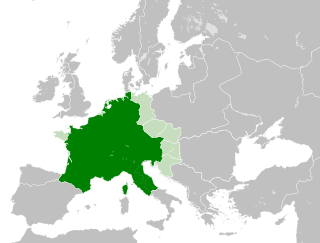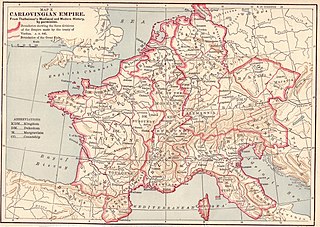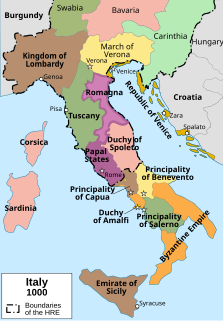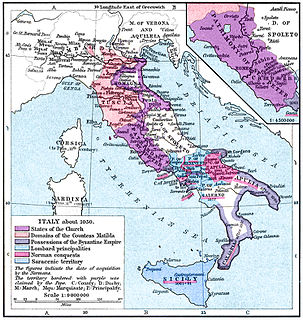 W
WThe Kingdom of Italy, also called Imperial Italy, was one of the constituent kingdoms of the Holy Roman Empire, along with the kingdoms of Germany, Bohemia, and Burgundy. It comprised northern and central Italy, but excluded the Republic of Venice and the Papal States. Its original capital was Pavia until the 11th century.
 W
WThe Carolingian Empire (800–888) was a large Frankish-dominated empire in western and central Europe during the early Middle Ages. It was ruled by the Carolingian dynasty, which had ruled as kings of the Franks since 751 and as kings of the Lombards in Italy from 774. In 800, the Frankish king Charlemagne was crowned emperor in Rome by Pope Leo III in an effort to transfer the Roman Empire from east to west. The Carolingian Empire is considered the first phase in the history of the Holy Roman Empire, which lasted until 1806.
 W
WThe March of Friuli was a Carolingian frontier march, established in 776 as the continuation of the Lombard Duchy of Friuli, established against the Slavs and Avars. It was ceded to the Duchy of Bavaria as the March of Verona in 952. Its territory comprised parts of modern-day Italy, Slovenia and Croatia.
 W
WThe Guelphs and Ghibellines were factions supporting the Pope and the Holy Roman Emperor, respectively, in the Italian city-states of central and northern Italy. During the 12th and 13th centuries, rivalry between these two parties formed a particularly important aspect of the internal politics of medieval Italy. The struggle for power between the Papacy and the Holy Roman Empire arose with the Investiture Controversy, which began in 1075, and ended with the Concordat of Worms in 1122. The division between the Guelphs and Ghibellines in Italy, fuelled by the imperial Great Interregnum, persisted until the 15th century.
 W
WThe March of Tuscany was a frontier march of the Kingdom of Italy and the Holy Roman Empire during the Middle Ages. Located in northwestern central Italy, it bordered the Papal States to the south, the Ligurian Sea to the west and Lombardy to the north. It comprised a collection of counties, largely in the valley of the Arno River, originally centered on Lucca.
 W
WThe Della Scala family, whose members were known as Scaligeri or Scaligers, was the ruling family of Verona and mainland Veneto from 13th to 14th century, for a total of 125 years.
 W
WThe Duchy of Spoleto was a Lombard territory founded about 570 in central Italy by the Lombard dux Faroald. Its capital was the city of Spoleto.
 W
WThe March of Verona and Aquileia was a vast march of the Holy Roman Empire in northeastern Italy during the Middle Ages, centered on the cities of Verona and Aquileia. Seized by King Otto I of Germany in 952, it was held by the Dukes of Bavaria; from 976 in personal union with the Duchy of Carinthia. The margravial regime ended with the advent of the Lombard League in 1167.